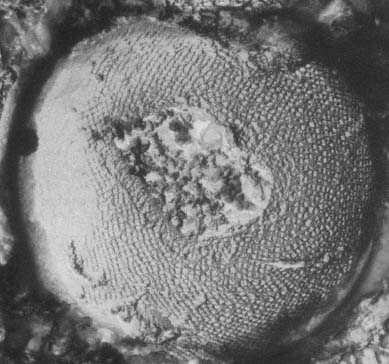Desulfurococcus mobilis: Difference between revisions
No edit summary |
No edit summary |
||
| Line 2: | Line 2: | ||
{{Biorealm Genus}} | {{Biorealm Genus}} | ||
[[Image:desulfur_cell.jpg|frame|300px|right|''Desulfurococcus mobilis''. Image from [http://www. | [[Image:desulfur_cell.jpg|frame|300px|right|''Desulfurococcus mobilis''. Image from [http://www.iceland-photos.com/photos/iceland-krysuvik-seltun-reykjanes-2-700x700.jpg.]]] | ||
Revision as of 01:07, 24 October 2011
A Microbial Biorealm page on the genus Desulfurococcus mobilis

Classification
Domain: Archea; Class: Thermoprotei; Order: Desulfurococcales; Family: Desulfurococcaceae ; Genus: Desulfurococcus; Species: mobilis.
Description and significance
Desulfurococcus mobilis is an extreme thermophile, living up to temperatures of 97° C and at a pH between 2.2 and 6.5. The species ranges in size from about 0.5 microns to 10 microns, and is covered with a unique, tetragonally-arrayed surface protein which forms a mesh of cross-shaped units. It is an anaerobe and is dependent upon sulfur for respiration. D. mobilis is found in solfataric (volcanic and sulfur emitting) hot springs and is most commonly isolated under these conditions in the country of Iceland. Its ability to survive in extreme conditions makes this archaeon valuable for uses in biotechnology, since thermostable and thermoactive enzymes can be isolated from this organism, like the restriction enzyme I-Dmol. Interestingly, the first known prokaryotic rRNA intron was discovered in D. mobilis, helping to give insights on the evolutionary relationship between archaea, bacteria and eukaryotes. Further, this organism is not a known pathogen.
Genome structure
D. mobilis contains a single and circular chromosome. It is not known to contain any plasmids. The genome of D. mobilis has not yet been sequenced, however its closest relative, Desulfurococcus mucosus was determined to have a genome size of 1.3 million bp. There exists a 622bp intron within the 23S rRNA gene with a splicing site in domain IV.
Cell structure, metabolism & life cycle
Provide a physical and biochemical description of the organism. What kind of organism is it, what does it look like, how is it built, what are its metabolic properties, how can it be identified, what is it's life cycle, &c. In other words, describe the organism from its perspective.
This organism is an organotroph and has a strictly anaerobic metabolism. It acquires energy by fermenting peptides. Its growth is dependent upon the reduction of sulfur and inhibited in the presence of hydrogen gas. The exterior of the organism is coated with irregularly arranged surface glycoproteins. These proteins form a lattice which is comprised of cross-shaped units. This protein coat is thought to function as a molecular sieve that mediates the adsorption of small to medium-sized molecules (>700kd).
Ecology (including pathogenesis)
Describe its habitat, symbiosis, and contributions to environment. If it is a pathogen, how does this organism cause disease? Human, animal, plant hosts? Describe virulence factors and patient symptoms.
Interesting feature
Describe in detail one particularly interesting aspect of your organism or it's affect on humans or the environment.
